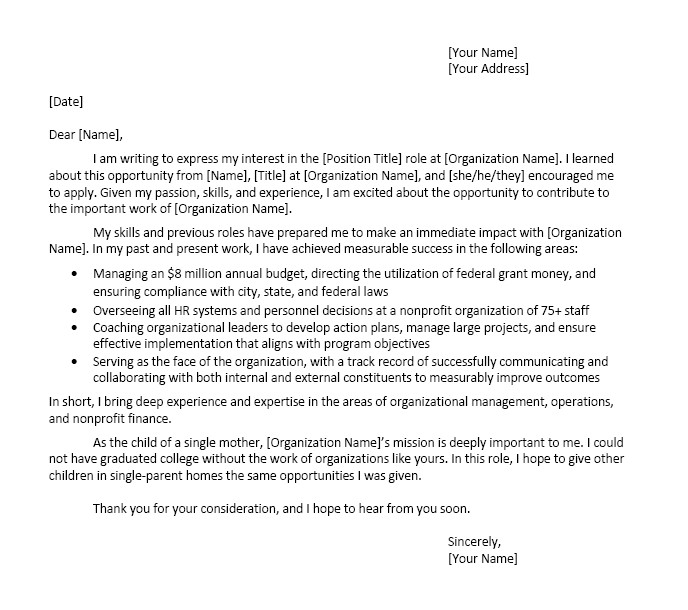This post is part of a series to help candidates in their nonprofit job search. This series is a work in progress, but all future articles will be posted HERE.
Your nonprofit job application needs to stand apart from the rest. Use your cover letter to show you are a great candidate and land an interview.
You may be shocked at how many people write one standard cover letter and apply for a million nonprofit jobs using the exact same text. Nonprofit recruitment is not only about identifying candidates with the necessary skills and experience. Our job as hiring managers is also to identify people who actually care about the role they are applying for. If I receive an application from someone who has not bothered to tailor their cover letter to the specific position, this is how I interpret it: “I haven’t put any effort into this application because I don’t care about this position and I probably won’t put much effort into my work, either.”
It only takes ten minutes to make sure you’re knocking it out of the park with your cover letter. Here’s a handy 5-step outline with easy ways to nail that first impression.
There are lots of different ways to structure your cover letter, but we recommend this basic five-part structure. It keeps things simple, and it helps you stay focused. At the bottom of this article, you will find a PDF template you can use. Here are the five parts:
Part 1: The Greeting
“To whom it may concern” might be fine if you are applying at Goldman Sachs, but nonprofits (especially small ones) value warmth and personal connection. As such, you should try to address your cover letter to the appropriate person. At Public Good Talent, we believe cover letters addressed to the initial screener (not the position’s supervisor) get the best results. After all, the goal of your application is to get in the door, and the gatekeeper is often different from the supervisor.
Many job postings will make it easy for you: “Send your cover letter and resume to Sally Jones at sjones@randomnonprofit.org.” Others will make it a little more difficult. If the posting does not give the name of the person receiving applications, check LinkedIn to find the HR Manager. On the nonprofit’s page, click on the “People” button on the left side to see all the employees. If it’s a small organization, it’s a safe bet that the HR Manager will be reviewing the applications, and you can address your cover letter to them. If you can’t find the name, don’t worry. You can always use “Dear Hiring Team” or “Dear Hiring Manager.” Properly addressing your cover letter is icing on the cake, not the cake itself, so don’t lose sleep over this.
Bonus Tip: Never address a person with “Mrs.” unless you are 100% sure this is the person’s preference. In all other cases, you should default to “Ms.” or “Mr.” or the person’s full name.
Part 2: Paragraph 1 – The Basics
The first paragraph of your cover letter is barely a paragraph. Simply cover the basics, express some excitement, and move on to the more substantive parts of your letter.
First, state your purpose: “I am writing to express my interest in the [Position Title] role at [Organization Name].”
Second, you might want to state how you heard about the opening. This is especially important if (a) the job posting specifically asks you to tell them where you saw the post, or (b) you have a valuable connection who recommended you apply. This can be as simple as, “I learned about this opportunity through LinkedIn.” If the posting was forwarded to you by an existing employee at the nonprofit or a connection who is well-known in the sector, this is absolutely worth highlighting, “I learned about this opportunity from [Name], [Title] at [Organization Name], and she/he/they encouraged me to apply.”
Finally, express excitement about the opportunity: “Given my passion, skills, and experience, I am very excited about the opportunity to contribute to the important work of [Organization Name].”

Part 3: Paragraph 2 – Highlight Your Skills and Experiences
This is where you highlight 3-4 (and no more!) skills and experiences that demonstrate your ability to do the job. Remember: Do NOT simply repeat your entire resume. Your resume is a much more exhaustive picture of your career. Your cover letter is an opportunity to make things easy on the screener by highlighting the big things they need to know.
We typically recommend carefully reviewing the job posting before writing this paragraph. Under “Required Skills and Experience,” most nonprofits will make it easy by listing the most important things first. If the job requires 2 years of supervisory experience, skills in leading strategic planning, and experience working with historically marginalized communities, those are the exact things you should highlight. If you do not have experience with every single requirement and you still think you are a qualified candidate, highlight another skill that you think is applicable.
Bonus Tip: Consider using bullets for this section. In many cases, we suggest using a traditional approach to your application materials, but this is an exception. In these modern times, attention spans are limited. There’s a reason “listicles” (like this one!) are so effective. You can break with tradition and use bullets to highlight your 3-4 big skills and experiences. When done well, it keeps the screener interested.
Part 4: Paragraph 3 – Connect With the Mission
Nonprofits are different from many traditional businesses. The leaders of the organization care deeply about the mission, and they want to build a team of folks who are equally passionate about the work. Whether you are applying to be a nonprofit executive assistant or a nonprofit CEO, your connection to the mission matters!
Your cover letter is the perfect place to highlight this connection. Tell a quick story. Share a quick anecdote. “As the child of a single mother, [Org Name]’s mission is deeply important to me. I would not have graduated college without the work of organizations like yours. In this role, I hope to give other children in single-parent homes the same opportunities I was given.” But remember: Keep it quick and to-the-point!
Even if you do not have a deeply personal connection to the mission, it is still important to express some passion for the cause: “As a child of two-parent household, I can only imagine the obstacles faced by single parents. In my previous experience working as a teacher, many of my students were raised by courageous single mothers. I would be thrilled to help these children realize their potential and give them the same opportunities I was given.”
Part 5: A Thank You, and a Closing
If you have used the previous four parts in a focused and concise manner, you have done everything you can. Now tie a bow on it and send it off! We recommend a final sentence before your formal closing. This sentence should simply thank the reader for their time and express some quick excitement for the next steps in the process. “Thank you for your consideration, and I hope to hear from you soon.”
As we said, we recommend keeping your cover letter relatively traditional and formal. As such, avoid informal closings like “Thanks” or “Take care.” Instead, stick with “Sincerely” or “Kind Regards.”
But wait, there's more!
If you have followed this guide, your cover letter is bound to be head and shoulders above 90% of the other applicants. But here are a few additional tips to help you take it to the next level.
Use a standard font
Can you imagine receiving a cover letter in Comic Sans? We couldn’t either, but it happened! Do not be that person. Use one of the gold standards: Times New Roman for serif, or Calibri for sans serif.
The half-page rule
Do NOT bore the screener. If we want to read novels, we can do that on our own time! We read cover letters to learn a bit more about you, see whether you have basic communication skills, and to make sure you can spell (more on that later). Do not make this more difficult for yourself by writing multiple pages. Stick to a half page. Maybe two thirds at the absolute most. Any more is going to frustrate the hiring manager, not impress them.

Proofread, proofread, proofread!
Better yet, have a friend proofread it. Screeners receive hundreds of applications, making it easy to simply toss aside candidates with grammatical or spelling errors in their cover letter. If you cannot be trusted to write an error-free cover letter, you are unlikely to be trusted with the important work of the nonprofit. Do not miss out on a great job opportunity because you forgot to use spellcheck.
Use the same language as the job posting
Do you come from a background in K-5 education, but the job posting requires experience in “elementary” education? Make it easier for them and use their language! If the posting emphasizes “experience working with under-represented and marginalized communities,” use that exact phrasing in your cover letter.
Consider preemptively addressing concerns
Do you have an extended gap in your employment that can be explained by an extraordinary life event, like the birth of a child or the death of a loved one? The cover letter is a perfect place to address this. “You may notice that I have a gap in employment starting this past spring. My first child was born in March, and I took some time off to care for him. I am excited to return to the work force full-time.”
There are other issues you may want to address in your letter. For example, if you are applying for an ultra-progressive environmental nonprofit and you have a decade of experience working for an oil and gas company, you need to say something about that. “My time working in the energy sector has given me a first-hand look at the damage humans are doing to our planet. I am committed to being part of the solution.”
Skip the “References available upon request” line
Of course your references are available upon request! And if we want them, we will request them. There’s no need to clutter your letter with this.
Don’t stretch the truth
You are terrific, and you can get an amazing job because of your skills and experience. Be proud of your accomplishments, and do not feel the need to embellish or stretch the truth. If the posting asks for “formal supervisory experience” and you have only supervised a team of three volunteers during a Saturday park cleanup, please do not suggest that you have experience supervising employees. Simply leave it out and highlight all the other incredible skills you would bring to the organization.
Public Good Talent is a boutique recruitment firm serving nonprofits and small businesses who are working to improve their communities. Based in Denver, Colorado, PGT serves organizations across the country.


Comments are closed.